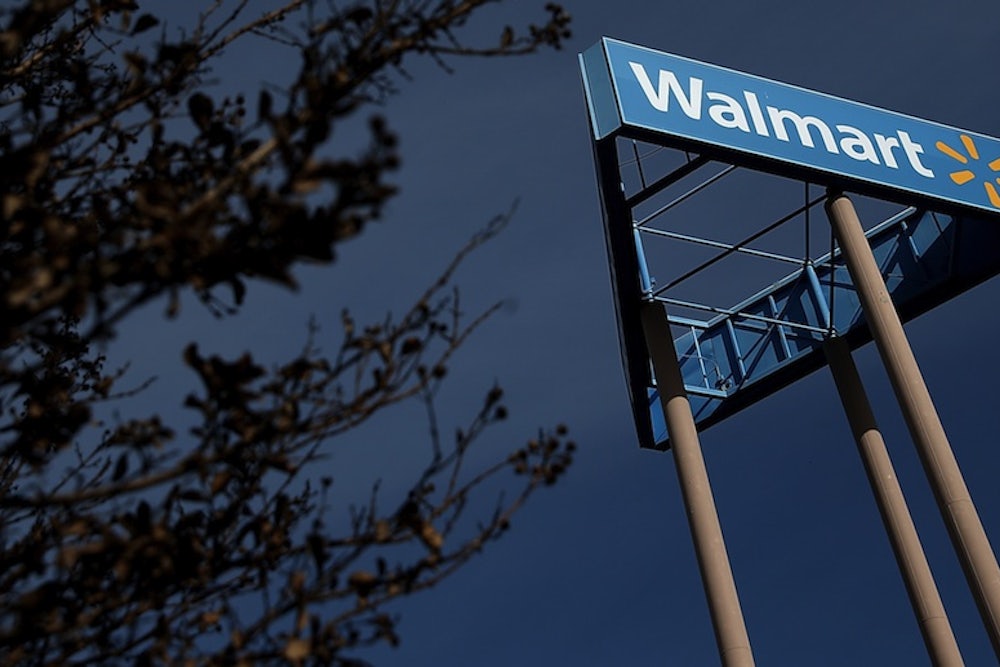The out-of-control U.S. health care system may finally have met its match: Walmart.
On Friday, the company opened a primary care clinic in one of its Texas stores. It’s the sixth such clinic that Walmart has established, with another six reportedly on the way by year’s end, according to a New York Times report from last week.
If you’re already a Walmart shopper, this might not seem like a big deal. You’ve probably seen clinics inside the stores before. But these new health centers are different. Previously, Walmart simply leased out space out to local hospitals, the way it frequently does to local banks or to Starbucks. With the new clinics, Walmart will be operating the facilities directly—paying for the supplies, hiring and managing staff, and taking in payments. The company has apparently decided that it can provide convenient, low-cost medical care—not just for minor injuries and illnesses, but even for more serious and chronic conditions.
Am I petrified? No. If anything, I'm a little optimistic.
Don’t get me wrong: There’s plenty about Walmart I don’t like, particularly when it comes to the treatment of its workers. But the U.S. appears to have a shortage of primary care providers. The population is aging and there aren’t enough general practitioners, family doctors, and geriatricians to take care of everybody. We’ll have to train some more doctors or, at least, open the borders to more of them who got their training overseas. But those steps won’t solve the problem on their own, at least in any reasonable span of time. We also need other ways to deliver medical care.
In-store primary clinics—versions of which you can already find at CVS, Target, and Walgreens—are one way to meet that need. These clinics rely more heavily on nurse practitioners and other non-physicians to deliver care. This is why they can ramp up quickly and address the growing need for services. This is also why the clinics can provide care for less money. Nurse practitioners and other professionals, though frequently well-paid, don’t command the same high salaries as physicians. And as any economist will tell you, the high price of physicians services is a significant factor in U.S. health care spending.
Walmart’s famously ruthless approach to cost-cutting has its downsides. It’s easy to imagine the company treating its medical employees badly or, maybe even worse, creating a system of medical care that isn't very good for patients. But the company also has a chance to be innovative, in ways that could benefit the public. It can make medical care easier to get, simply by providing routine care at more convenient times (like a Sunday afternoon, when your doctor's office probably isn't open). Walmart can also use its buying power to bargain for better prices from drug makers and suppliers. As Dan Diamond of the Advisory Board notes, the two South Carolina clinics are in two of the poorest parts of the state—where the need for cheap health care is greatest, particularly since South Carolina hasn’t expanded its Medicaid program.
Ideally, Walmart would integrate its operations with larger networks of doctors and hospitals—the way Walgreens has in a few places—so that the clinics would become a way to introduce patients with more serious medical conditions to the facilities and specialists they will inevitably need at various times.
What are the chances the experiment works out well? I don’t know. But I’ll be rooting for it to succeed.
—Jonathan Cohn
News from the weekend:
RACE AND A SHOOTING IN ST. LOUIS: On Saturday, an unarmed African-American teenager in a St. Louis suburb was shot and killed by police—allegedly after the young man attacked an officer, though the details remain murky. On Sunday, there were protests, vigils, and, eventually, some confonrtations and looting. The police officer has been put on administrative leave while authorities, working with the FBI, investigate what happened. Community leaders say the incident is emblematic of long-standing tension between the predominantly black community and the predominantly white police force. (St. Louis Post-Dispatch, New York Times)
COLLEGE SPORTS: The NCAA is plotting its next legal and financial moves, after a federal judge on Friday ruled that the association cannot prohibit payment of college athletes. (Wall Street Journal)
Stuff worth reading:
How dare she?! Jessica Valenti asked a simple question on twitter: Are there countries out there that subsidize the purchase of tampons? The responses were downright ugly. (Jezebel)
Avoid Beijing. Maybe try Shenzen or Lhasa. The Chinese government is currently monitoring air in 161 cities, to see if the quality meets new, stricter standards. It did in only 9 of them. (New York Times)
Should the full D.C. Circuit hear the appeal of Halbig? Two lawyers have it out. Nicholas Bagley says yes. Adam White says no. (Incidental Economist, Wall Street Journal)
Best domestic policy article of the weekend: It’s by Neil Irwin, it’s about truckers, and it will teach you something about why wages for lower- and middle-income workers have stagnated. (The Upshot)
Stories we’ll be watching:
The controversy over that shooting in St. Louis could blow up into something bigger. Meanwhile, the president is still mulling what to do on immigration policy. But foreign policy may continue to be the dominant news.
At QED:
Rebecca Leber debunks a favorite conservative talking point: That the planet has stopped warming and may even be “cooling.” Howard Markel, a physician and expert on epidemics, answers questions about Ebola. Also, don’t miss Jason Zengerle’s article at the New Republic about Alabama, race, and what he calls the “end of the Second Reconstruction.”
